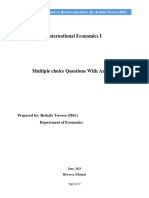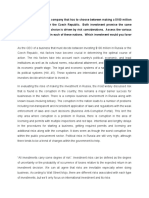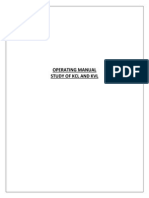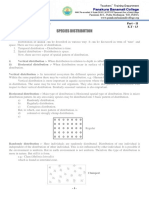100%(1)100% found this document useful (1 vote)
163 viewsQUIZ 3 Global Trade For Students
Accounting information addresses three different functions like (1) providing information to external parties for investment and credit decisions (2) estimating the cost of products produced and services provided by the organization; and (3) providing information useful to internal managers who are responsible for planning, controlling, decision making, and evaluating performance.
Financial accounting is designed to meet external information needs and to comply with generally accepted accounting
Uploaded by
Lyka M. ManalotoCopyright
© © All Rights Reserved
Available Formats
Download as DOCX, PDF, TXT or read online on Scribd
100%(1)100% found this document useful (1 vote)
163 viewsQUIZ 3 Global Trade For Students
Accounting information addresses three different functions like (1) providing information to external parties for investment and credit decisions (2) estimating the cost of products produced and services provided by the organization; and (3) providing information useful to internal managers who are responsible for planning, controlling, decision making, and evaluating performance.
Financial accounting is designed to meet external information needs and to comply with generally accepted accounting
Uploaded by
Lyka M. ManalotoCopyright
© © All Rights Reserved
Available Formats
Download as DOCX, PDF, TXT or read online on Scribd
You are on page 1/ 5
Chapter Test-Global Trade
Instruction: Write the capital letter of your answer.
1. Why should managers in international business understand international trade theories?
A. If they face supply shortages in their domestic market, it helps them to find suppliers
abroad.
B. Countries enact trade policies based on trade theories, which, in turn, affect companies’
optimum production locations.
C. The theory is essential in determining the best pricing strategy to use when exporting.
D. The understanding helps them decide whether to embrace PLC versus factor proportions
theory when seeking to sell abroad.
2. The trade theory that premises a country’s wealth is measured by its holdings of treasure,
usually in gold, is known as ______.
A. Bullionism
B. The Porter Diamond
C. Monetarism
D. Mercantilism
3. ____holds that there are advantages to trade because different countries can produce different
goods more efficiently than others.
A. The product life cycle theory
B. A favorable balance of trade
C. The tradable goods theory
D. The theory of absolute advantage
4. Comparative advantage holds that there is a basis for trade when Country A specializes ____.
A. in new products and Country B specializes in mature products.
B. In producing the product it can produce more efficiently than another product even though
Country B can produce both products more efficiently than Country A.
C. In labor-intensive products and Country B specializes in capital-intensive products.
D. In producing those goods and services it can produce more efficiently than Country B.
5. Adam Smith, in his theory of absolute advantage, reasoned that specialization of production
would lead to greater efficiency. He gave all of the following reasons EXCEPT:
A. specialized labor would immigrate to countries better able to use their skills.
B. labor would not lose time in switching from the production of one kind of product to
another.
C. long production runs would provide incentives for the development of more effective
working methods.
D. labor could become more skilled by repeating the same tasks.
6. Countries with large land areas are generally less dependent on trade than countries with small
land areas. One of the factors causing this difference is that large countries _____.
A. typically speak languages that are not official elsewhere.
B. are more apt to have varied climates and natural resources
C. have more people.
D. can support long production runs.
7. The factor proportions theory of trade says that a country will have its best trade advantage if it
concentrates on ______.
A. producing products using its abundant production factors.
B. producing products using its scarce production factors.
C. exporting its expensive products.
D. importing labor-intensive products and exporting capital-intensive ones.
8. The country similarity theory of trade is a departure from earlier trade theories in that it _____.
A. prescribes that similar countries should not attempt to develop specialization as a means of
trading with each other.
B. shows that most world trade occurs among developed countries rather than between
developed and developing countries.
C. says that small countries trade primarily with each other and so do large countries.
D. says that the greater benefits from trade will come when the economic gap between
developed countries and developing countries is lessened.
9. The product life cycle (PLC) theory of trade theory holds that _____.
A. exports will be higher for products that go through a cycle than products that do not.
B. countries are better off if they concentrate on products not likely to become obsolete
because of innovations.
C. products’ location of production will shift internationally depending on the stage in the life
cycle.
D. durable products will be exported more than perishable ones.
10. The identification by a government of target industries to be competitive internationally is a(an)
______.
A. import substitution policy
B. strategic trade policy
C. export-led development policy
D. example of central planning
11. All of the following are conditions of the Porter Diamond EXCEPT _____.
A. governmental assistance conditions.
B. demand conditions
C. related and supporting industries.
D. factor conditions.
12. The term used to describe a country’s loss of highly educated productive human resources is
known as _______.
A. brain drain
B. a Porter Diamond by recipient countries and a diamond in the rough by origin countries.
C. dual development
D. an unfavorable balance of trade
13. The international movement of production factors as an alternative to trade ______.
A. will force consumers in some countries to forgo buying certain products.
B. increases world output and decreases prices concerning what trade would do.
C. guarantees that global economic efficiency is maximized.
D. may or may not lead to a more efficient global allocation of resources.
14. Governmental restrictions and incentives to trade are known as _____.
A. customs valuation
B. protectionism
C. terms of trade
D. import substitution
15. Assume a country limits imports to increase domestic employment. The limitation may fail to
work fully for all the following reasons except ____.
A. other countries retaliate with restrictions of their own
B. employees will move from an unprotected industry to a newly protected one
C. importing companies decrease their employment
D. consumers abroad lose the income that they might otherwise use to buy from the
protective country
16. All of the following are reasons given for developing countries to use import protection to spur
industrialization except _____.
A. prices of manufactured products historically rising faster than the prices of primary products
B. the fear that developed countries will cease supplying them with manufactured products
C. the need to diversify dependence on primary products because of wide swings in their
prices.
D. developed countries tend to grow more rapidly than developing countries
17. Import substitution is _____.
A. an industrialization program promoting products that would otherwise be imported
B. the protection of strategic industries
C. the number of imports that a given quantity of a country’s exports can buy
D. an industrialization policy emphasizing industries that will have export capabilities.
18. Countries sometimes establish export restrictions to ____.
A. lower prices in the domestic market
B. prevent smuggling
C. lower prices in foreign markets
D. encourage the development of substitute products
19. Dumping is the ______.
A. overpricing of imports
B. blaming other countries for trade imbalances
C. underpricing of exports
D. export of hazardous materials
20. In addition to setting the total amount to be traded, quotas sometimes allocate based on
_______.
A. currency of payment
B. quality
C. price
D. country
21. All countries face the questions of what, how much, and with whom they should export and
imports.
A. True
B. False
22. Under mercantilism, governments sought to influence trade by limiting imports and subsidizing
exports.
a. True
b. False
23. The theory of absolute advantage holds that a country will gain from trade even though it can
produce all goods more efficiently than other countries.
A. True
B. False
24. Gains from trade in comparative advantage theory hold that the gains are due to economies of
scale that reduce cost.
A. True
B. False
25. The factor proportions theory holds that a country will benefit most from trade by importing
labor-intensive products and exporting capital-intensive products.
A. True
B. False
26. Trade among developed countries occurs primarily because they specialize in
different agricultural products.
A. True
B. False
27. At an early stage of a product’s life cycle, the product is apt to be made in a more
capital-intensive method than in its later stages.
A. True
B. False
28. A consumer durable product is more apt to behave according to the product life cycle theory of
trade and development than a product with very rapid obsolescence.
A. True
B. False
29. The most internationally mobile factor of production is labor.
A. True
B. False
30. Poor countries have sometimes received more in remittances from their citizens who have gone
abroad than they have received from their exports.
A. True
B. False
31. If a country cannot gain foreign production factors to use in its domestic operations, it may be
stimulated to adopt efficient substitute methods of production.
A. True
B. False
32. Trade protectionism may limit a company’s ability to sell abroad
A. True
B. False
33. When a government imposes import restrictions to help a sensitive industry at home, it is apt to
hurt another one of its industries.
A. True
B. False
34. Exports may stimulate imports by increasing foreign income.
A. True
B. False
35. Terms of trade refer to specific requirements placed on imports at the port of entry.
A. True
B. False
36. Export-led development refers to the use of export tariffs to provide revenue for infrastructure
development.
A. True
B. False
37. The comparable access arguments for trade restrictions say that by imposing trade restrictions,
foreign companies will lower their prices.
A. True
B. False
38. Countries sometimes establish export restrictions to retaliate against import controls.
A. True
B. False
39. Dumping is the export of hazardous materials.
A. True
B. False
40. In addition to protection, tariffs serve to subsidize exports.
A. True
B. False
You might also like
- SIE Exam Practice Question Workbook: Seven Full-Length Practice Exams (2024 Edition)From EverandSIE Exam Practice Question Workbook: Seven Full-Length Practice Exams (2024 Edition)5/5 (1)
- International Trade 4th Edition Feenstra Taylor Test Bank100% (50)International Trade 4th Edition Feenstra Taylor Test Bank101 pages
- Submitted By: Mr. Alfie G. Rellon (FB and Messenger) (AMA OED Student) (Agrsaudi: Username in The Site)No ratings yetSubmitted By: Mr. Alfie G. Rellon (FB and Messenger) (AMA OED Student) (Agrsaudi: Username in The Site)12 pages
- Andreas B. Imhoff, Jonathan B. Ticker, Augustus D. Mazzocca, Andreas Voss - Atlas of Advanced Shoulder Arthroscopy-CRC Press (2018)No ratings yetAndreas B. Imhoff, Jonathan B. Ticker, Augustus D. Mazzocca, Andreas Voss - Atlas of Advanced Shoulder Arthroscopy-CRC Press (2018)389 pages
- 9853 6871 20b Spare Parts Catalogue COP 1435 PDFNo ratings yet9853 6871 20b Spare Parts Catalogue COP 1435 PDF55 pages
- Test_12,_Theories_of_International_Trade_ _instruments_25_10_202No ratings yetTest_12,_Theories_of_International_Trade_ _instruments_25_10_2024 pages
- SOLUTIONS International Trade Practice QuestionsNo ratings yetSOLUTIONS International Trade Practice Questions18 pages
- Multiple Choice Tutorial: International TradeNo ratings yetMultiple Choice Tutorial: International Trade35 pages
- IBT 401 - International Business and Trade Reviewer100% (3)IBT 401 - International Business and Trade Reviewer7 pages
- International Economics - Advanced MCQ Test BankNo ratings yetInternational Economics - Advanced MCQ Test Bank11 pages
- PDF Test bank for International Trade 4th Edition Feenstra Taylor 1319061737 9781319061739 download100% (13)PDF Test bank for International Trade 4th Edition Feenstra Taylor 1319061737 9781319061739 download41 pages
- Chapter 5: International Trade: Learning ObjectivesNo ratings yetChapter 5: International Trade: Learning Objectives44 pages
- Kanpur Institute of Higher Education, Kanpur: Time:45 Minutes Total Marks: 100No ratings yetKanpur Institute of Higher Education, Kanpur: Time:45 Minutes Total Marks: 1002 pages
- Collectivism Refers To A Political System That Stresses The: Cross-Cultural Literacy Mean An Understanding of HowNo ratings yetCollectivism Refers To A Political System That Stresses The: Cross-Cultural Literacy Mean An Understanding of How9 pages
- Complete - Lec01-06 - CT Signals and TD AnalysisNo ratings yetComplete - Lec01-06 - CT Signals and TD Analysis103 pages
- Get Brutal Design 1st Edition Solomon Zachary PDF ebook with Full Chapters Now100% (10)Get Brutal Design 1st Edition Solomon Zachary PDF ebook with Full Chapters Now28 pages
- Time Leisure and Well Being 1st Edition Jiri Zuzanek pdf download100% (1)Time Leisure and Well Being 1st Edition Jiri Zuzanek pdf download58 pages
- Chapter 9 Mechanical Properties of SolidsNo ratings yetChapter 9 Mechanical Properties of Solids16 pages
- C264 Application: Modular Remote Terminal UnitNo ratings yetC264 Application: Modular Remote Terminal Unit4 pages
- Chem Grade 9 Answer Key of End Chapter QuestionsNo ratings yetChem Grade 9 Answer Key of End Chapter Questions3 pages






























































































